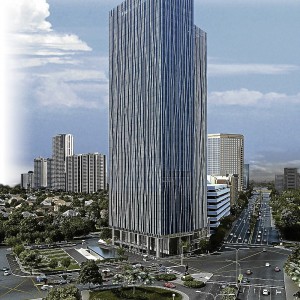
THE ZUELLIG Building ‘raises the bar for green building standards in the Philippine prime office market.’
A 33-story Makati office tower that uses the same sustainable technology being used in the Freedom Tower in New York puts the Philippines in the green world map.
The Zuellig Building, sheathed in 28,000 square meters of floor-to-ceiling low-emissivity glass, joins the ranks of the world’s most state-of-the-art, environment-friendly buildings like the Bank of America Tower-New York City, Asia Square in Singapore, and Taipei 101.
All in all, there are only about a hundred LEED Platinum-certified high-rise office buildings worldwide. The Zuellig Building now joins this elite group.
Platinum certification
The US Green Building Council (USGBC) awarded the Zuellig Building the Platinum certification level under its LEED-CS (Leadership for Energy and Environmental Design-Core and Shell) program this month. Platinum, the highest level of LEED certification, is actually an upgrade for Zuellig Building, which was awarded at precertification the Gold level under LEED-CS in June 2009.
The Zuellig skyscraper that stands on a landscaped 8,285-square-meter site at the intersection of Makati Avenue and Paseo de Roxas is the first development in the Philippines in the LEED-CS program, and among the first in Asia, to earn the highest level in the LEED rating system for “green” architecture, sustainable construction methodologies and resource-efficient building operations. The property has a total leasable area of 55,000-sq-m prime-grade office space for multitenant use.
Based on available data from the USGBC, there are only three Platinum-certified projects in the Philippines. The other two are Bridgebury Realty Corp. Office, developers of the Zuellig Building (LEED Platinum for Commercial Interiors), and the Sunlife Philippines head office in Taguig (LEED Platinum for Commercial Interiors).
CBRE Philippines told Inquirer Property in a statement that “as the outsourcing and offshoring sector gains strength in the country, we see more occupiers and developers prioritizing flight to quality, with green buildings becoming more the norm than the exception.”
It added that the Zuellig Building “raises the bar for green building standards in the Philippine prime office market.”
The team of architects and design consultants behind the Zuellig project included W.V. Coscolluela & Associates and Skidmore Owings & Merrill (SOM, New York), the same company behind the Freedom Tower. Adherence to LEED requirements was monitored throughout the construction process by the project’s sustainability consultant, Langdon & Seah.
Environmental impact
Experts have stressed that the construction sector is one of the most significant contributors to the carbon footprint of the industrial sector. Also, studies have shown that buildings account for over half of the world’s carbon emissions, making their impact on the environment a key concern. This is specially evident in Asia with its rapid growth of highly urbanized populations.
Initiated by the USGBC in 2000, LEED is recognized as a global standard for the assessment of the sustainability of buildings.
The LEED-CS rating system allocates points based on a building’s environmental impact and human benefits in five major credit categories: sustainable sites, water efficiency, energy and atmosphere, materials and resources, and indoor environmental quality.
Each of the performance categories includes preconditional mandatory measures. Certification is granted solely by the USGBC in Washington, DC and requires third-party verification of compliance.
The green technologies employed in the Zuellig Building achieve significant energy savings (at least 15 percent compared with a base building built to conventional US standards), thereby reducing greenhouse emissions and energy costs.
The building has an on-grid photovoltaic solar power system to generate renewable energy. Recycling of gray water and the collection of rainwater and condensate water result in over 70-percent water savings (29-million liters annually).
Access to public transport
With transportation being another major contributor to worldwide carbon emissions, the location of the Zuellig Building allows tenants easy connectivity and access to public transportation. Bicycle stands and showers are provided for office users who choose to pedal to work instead of burning fuel.
Green buildings are designed to support the well-being and productivity of occupants. In the Zuellig Building, 90 percent of the office space gets natural light. The Indoor Air Quality plan controls the choice of construction materials to eliminate the health risks of volatile organic compounds, and carbon dioxide sensors control and modulate the airflow.
Zuellig also received a Platinum LEED-CI certification (Commercial Interiors) for the fit-out of its corporate offices on the 32nd floor. Tenants who desire a LEED-CI certification for their individual fit-outs automatically gain a certain number of points simply by being located in the building.